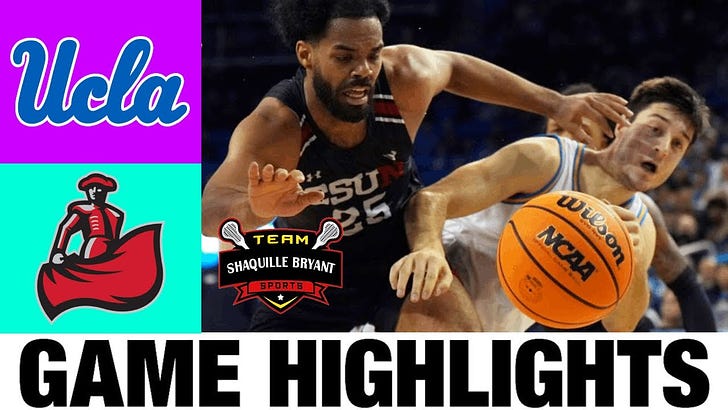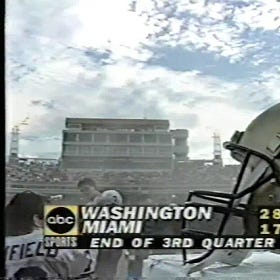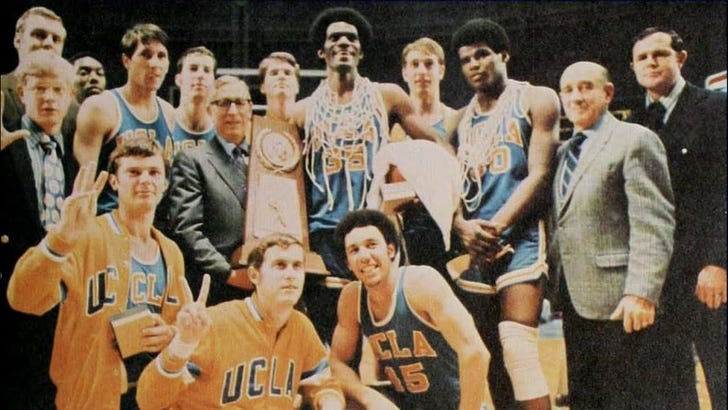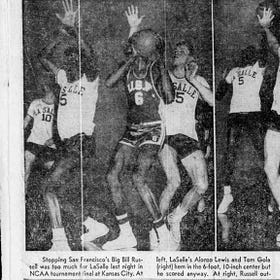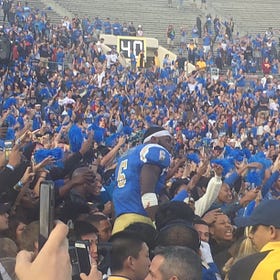Big West Basketball Is Quietly Commanding Your Attention
Western college basketball’s landscape is crowded with stories this season. It’s the last campaign for the Pac-12 as we know it, a Mountain West Conference that produced the national runner-up a season ago may be the best collectively it’s ever been, and Grand Canyon’s continued rise from the WAC begs a conversation about the implications of a for-profit institute growing its national profile through sports.
Add Gonzaga’s omnipresence out West, and there’s little spotlight left for the Big West Conference. But Big West basketball should absolutely be on every college basketball fan’s radar before March.
Before digging into the 2023-24 Big West, some background:
Big West basketball boasts one of the more impressive lineages among mid-major conferences. Between Utah’s Final Four runs in 1961 out of the Skyline Eight and in 1998 via the WAC, the Big West was the only Western league aside from the various iterations of the Pac-12 to send a team to the national semifinals.
A handful of independents in the West reached the Final Four in that 37-year stretch between Utes runs. It’s noteworthy, however, if not telling, that two of those three independents — 1970 semifinalist New Mexico State and 1977 semifinalist UNLV — landed in the Big West not long thereafter.
New Mexico State and especially UNLV launched a golden age for the Big West. The Runnin’ Rebels shook up college basketball in a manner paralleling Miami Hurricanes football of the same era.
From The Archives: "Whammy in Miami," The Rise and Fall of Miami Hurricanes Football
The following originally appeared on Patreon in July 2020. _________ In sports, as in life, nothing lasts forever. Still, inevitable conclusions are no less shocking when that bell tolls — from Michael Jordan's walk-off jumper to cap the Bulls dynasty, to Tom Brady's pick-six thrown against Tennessee that signaled an end to his role spearheading arguably…
The forerunners to the captivating Runnin’ Rebels teams under coach Jerry Tarkanian in the 1980s were Tarkanian’s Long Beach State squads in the ‘70s.
Tarkanian, and Lute Olson following him, refined the high-tempo brand of basketball that produced national championships for each later in their careers with their stops at Long Beach State.
Tark’s 49ers teams knocked on the door of the Final Four before running up against the John Wooden-helmed UCLA dynasty.
But with a restructured NCAA Tournament by 1977 and Wooden retired, a Tarkanian-coached team broke through to the Final Four for the first of four times in 14 years.
Three of those came in a five-season window with UNLV carrying the banner for the Big West, starting with a 1987 team that embraced the 3-pointer in a forward-thinking way the NBA wouldn’t adopt for another three decades.
UNLV peaked with its 1990 national championship, which remains both the first title won by a Western program outside of the Pac since the Bill Russell-led San Francisco teams of 1955 and 1956, and the last such crown.
Final Four Fact February: The Legend of Bill Russell Begins
Let’s start this edition of Final Four Fact February with a recommendation of the new Netflix documentary chronicling the life and career of Bill Russell, Legend. A must-watch for any basketball fan.
Though UNLV was the clear headliner, the top of the Big West in this era was damn good collectively. New Mexico State was a regular NCAA Tournament qualifier, and Long Beach State enjoyed a resurgence under Seth Greenberg1.
UC Santa Barbara also reached the NCAA Tournament in 1988 before the PCAA rebranded as the Big West, then again in 1990. The Gauchos had a run of three straight seasons and 4-of-5 winning at least 20 games during the height of the Big West, and the Thunderdome in the heart of Isla Vista rocked for conference games.
ESPN’s Big Monday prominently featured the Big West in this era, at a time when the network really pushed college basketball as a cornerstone of its catalog. I have memories of being a youngster, just getting into the game for the first time, negotiating with my dad to stay up for some of those Big West telecasts.
That’s all to say this is a conference with a rich history.
Like so many basketball leagues, it suffered from programs chasing football money elsewhere and otherwise abandoning the sport altogether.
Two-Team Town: A History of College Football in Los Angeles
Maybe it’s the San Gabriel Mountain backdrop against which the Rose Bowl sits, or the iconic Hollywood sign and skyscrapers of downtown Los Angeles visible from Los Angeles Memorial Coliseum. Perhaps credit belongs to the contrast of USC’s cardinal-and-gold against UCLA’s blue-and-gold, making for what’s undeniably the most aesthetically pleasing unifor…
Three present-day Big West members shuttered their football games in less than a decade with Cal State Fullerton and Long Beach State shutting down in the early ‘90s, and Cal State Northridge calling it quits in 2001.
CSUN football spent its last season of existence as a Div. I-AA independent, the result of the university athletic department accepting membership in the Big West beginning in 2001.
The Matadors were members of the Big Sky for a few years previously in an odd geographic fit but marriage of convenience as the school endured growing pains in its transition from Div. II.
In the same calendar year as Cal State Northridge football shutting down and the athletic department as a whole joining the Big West, Matadors basketball faced Kansas in the 1st Round of the NCAA Tournament — the program’s biggest game to that point in its existence.
Marquee moments for the Matadors in the 22 years since have been few and far between, despite attracting some intriguing head coaches to the San Fernando Valley.
Reggie Theus — a member of the aforementioned 1977 UNLV Final Four team and an NCAA Tournament-qualifying head coach at New Mexico State in the mid-2000s — never got it going at CSUN.
Successor Mark Gottfried arrived in 2018 with name recognition and plenty of baggage. He was hired as Matadors coach while under investigation for rules violations, then was put on leave (which evolved into his dismissal) for further violations in 2021.
Trent Johnson, who’d had some success at Nevada and Stanford, won seven games in each of his two seasons helming CSUN.
Andy Newman’s already surpassed that mark in his first season as Matadors head coach, and won No. 8 in spectacular fashion.
Cal State Northridge dominated UCLA virtually wire-to-wire on Tuesday, en route to a 76-72 win. The decision ended the Bruins’ 29-game home-court winning streak, which was the longest in the nation going in.
Now, deeming the win the biggest in CSUN basketball history is a stretch. The overtime win over Pacific in the 2009 Big West Championship Game to advance to the program’s second-ever NCAA Tournament and the defeat of Eastern Washington to advance to the 2001 Big Dance have far greater direct implications.
What’s more, the UCLA of 2023-24 is a far cry from the Final Four-qualifying and contending teams Mick Cronin fielded from 2021 through last season. The Bruins’ 29th straight home win came Nov. 30 in a one-point escape against Cal State Northridge’s Big West counterpart UC Riverside — though that is a result worth revisiting in a moment.
Nevertheless, CSUN not just beating but thoroughly dominating the blue-blood program in its area sends a message just the same.
Further, the Matadors become the third Big West team to knock off a power-six conference opponent this season.
UC Irvine beat USC when the Trojans were ranked in the top 20 in mid-November, the same week that Long Beach State ran past Michigan in Ann Arbor behind a monster performance from Marcus Tsohonis.
Tsohonis has been outstanding this season for the Beach, particularly in high-profile spots. He led Long Beach State to another road win over a power-conference foe on Dec. 10, spoiling the debut of Bronny James with 28 points in an overtime win.
Long Beach State is a healthy No. 126 in KenPom rankings ahead of the holiday, one of four Big West teams in the top 150.
UC Santa Barbara checks in at No. 143, with Hawai’i at No. 113. The Rainbow Warriors have the chance to climb over Christmas weekend at the Diamondhead Classic, playing in a field that includes a pair of NCAA Tournament-quality squads in TCU and Nevada.
Hawai’i saw Nevada last Sunday in an outstanding game, falling just short but making a statement about the Rainbow Warriors’ toughness.
Coach Eran Ganot has done an excellent job in his tenure as Hawai’i coach, highlighted with the Rainbow Warriors’ 2016 NCAA Tournament upset of Cal.
The 2023-24 Rainbow Warriors lack the sheer talent of the 2015-16 squad, which built around rangy, athletic big man Stefan Jankovic. However, Noel Coleman and Juan Munoz are dangerous 3-point shooters and Hawai’i has dependable paint presence with Bernardo da Silva and Justin McKoy.
UH has an NCAA Tournament-quality lineup — and it’s much better than a No. 16 seed.
Fox’s Mike DeCourcy published a bracketology this week that made me roll my eyes for a few reasons, one of which was producing bracketology in December. The other was pairing Hawai’i as a No. 16 seed against top seed Arizona, the rare forecast that imagines to be insulting to both participants.
Hawai’i’s much better than a 16, and a team with a 113 KenPom would not be seeded so poorly. The top-rated No. 16 in 2023 per KenPom was Northern Kentucky at 160; in 2022, it was 172 Wright State.
For Arizona, getting a draw of that caliber a year after facing a woefully under-seeded Princeton might cause a run on tinfoil in Tucson.
Based on recent historically precedent, a KenPom near 100 is more likely to produce a No. 14 seed; maybe a 13, which UC Irvine was in 2019 when it scored the Big West’s most recent NCAA Tournament win.
The Anteaters have been consistently in the mix atop the conference throughout coach Russell Turner’s tenure. This year’s team has faced an absolute gauntlet with four KenPom top 100 matchups thus far, including the win at USC, and another on the day this newsletter drops when UC Irvine visits New Mexico.
Each of these games have been on the road, including the most recent: A 63-62 loss at San Diego State.
UC Irvine had last season’s runners-up on the ropes until a last-minute flurry saved the Aztecs. The Anteaters climbed to No. 63 in KenPom this week and will be especially battle-tested come the start of Big West play.
Now, the near-miss at San Diego State comes with the caveat UC Irvine faced an Aztecs lineup down Jaedon LeDee. A fair point, to be sure. But San Diego State only escaped with a win over another Big West team, UC San Diego, because of LeDee’s heroics.
Upstart UCSD and UC Riverside, teams likely to finish in the lower half of the Big West standings, each took California’s two biggest basketball brands to one-point finishes. That’s not insignificant.
Neither is the Big West as a whole this season. A potential, if not likely bracket-buster will probably come from the conference. I recommend getting on-board before the rest of the nation and checking the league out in the coming months.
Long Beach State’s coaching history from Tarkanian’s arrival in 1968 through Greenberg’s tenure into 1996 is fascinating. Tark and Olson are two of the top coaches of their eras, Greenberg is a face for the sport today through his broadcasting work on ESPN, and Tex Winter’s offense transformed the NBA in the 1990s.

